A taste of the cruising life
Naousa Paros, Greece Our friends Kathy and Carol left Berkeley East in the nick of time. While their final dinghy...

Cala del Core Ponza, Italy
We seldom end a cruising season where we began. In fact, we typically prefer making new discoveries to repeating past experiences. But this year was an exception. While we had hoped to be in Spain for winter, our longing to revisit Northern Italy, the French Riviera, Corsica, and Sardinia, combined with European Union restrictions, made a return to our previous winter marina in Gaeta, Italy the logical choice. So we did a loop, to the north, and the west, then south. And when weather dictated a move from Sardinia, we completed the 150-mile crossing east to Ponza, the beautiful Italian island where Berkeley East had her first landing of 2018.

Berkeley East can only travel about 95 miles in late-summer daylight hours, so it was essential that we do an overnight passage for the 150 miles to Ponza. We’ve had some wonderful night crossings, and we’ve had some pretty rough experiences as well; dealing with issues in the dark adds a level of complexity to sailing. With one-night passages, it is easier to plan for good conditions, which is what we did, so we enjoyed the benefit of a nearly full moon and rather benign conditions. A little sailing, a little motoring, a bit of boat traffic, a bit of rain; we arrived in Ponza tired, but unscathed.

We had just over two weeks left before taking Berkeley East into the marina for her winter preparation and pampering, and we hoped to spend our last days aboard BE in Ponza. We have a love-hate relationship with Ponza, having spent some of our very best days there, as well as some of our most difficult nights. But we have learned how to handle Ponza’s turbulent personality. When any wind comes from the east, any wind at all, we go to the west side of the island. And when conditions are from the west, north or south, we protect ourselves behind the cliffs on Ponza’s east side. It’s simple.


To truly appreciate Ponza, one must gaze upon the island from the sea. Sheer cliffs in a full palette of whites and golds, with splashes of greenery, fall into azure waters. Sandy beaches, ancient grottos and rocks resembling works of art complete the enchanting picture. There is nothing like feeling the gentle roll of Berkeley East while relishing the magnificent views of Ponza.

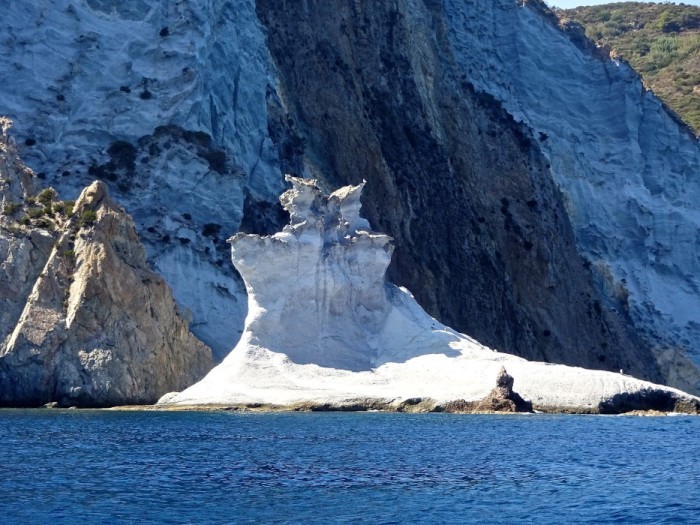

During high season, mainland-Romans descend on Ponza in droves, either by ferry, or private yacht. Those without their own boat rent small inflatables to explore the island, a valid drivers license being all that is required, no boating experience necessary.
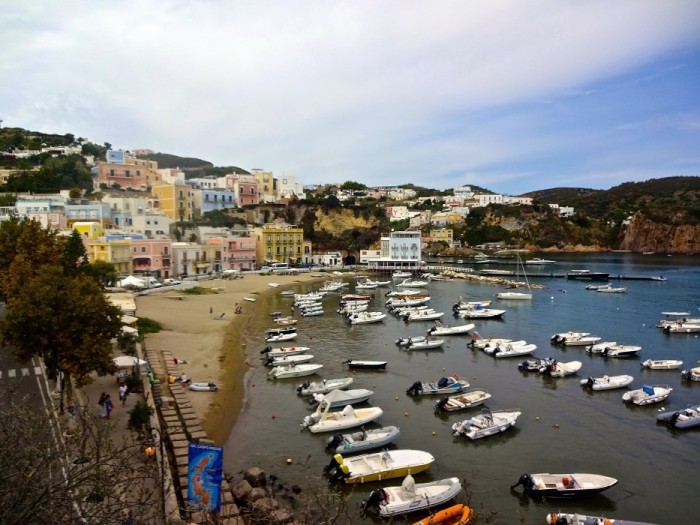
But modern Romans are not the first to enjoy Ponza’s unique beauty. In Imperial times, nobility built villas on the island with panoramas of the rocks and sea. After the fall of the Empire, the island was abandoned until 1734 when Porto, Ponza’s main town, was founded. Despite its summer popularity, Porto has retained much of it simple fishing village ambiance. Cafes, produce stalls and fishmongers surround the port, fishing boats fill the harbor, pastel buildings create a picture-perfect mosaic backdrop.

We were just a few days shy of September and the Italian holidaymakers were still out in force. But this was a different atmosphere from the Sardina jet set. These were typical Italians; lively and loud, smiling and happy, friendly and inquisitive as to what such a beautiful American-flagged boat was doing in Ponza. Boats would circle Berkeley East, moving uncharacteristically slowly, to look at her hailing port. Families happened by in small ribs and lingered asking questions about our life. Power boaters waved and yelled as they passed to see if we were really American. Swimmers paddled around BE until we came on deck for a chat.
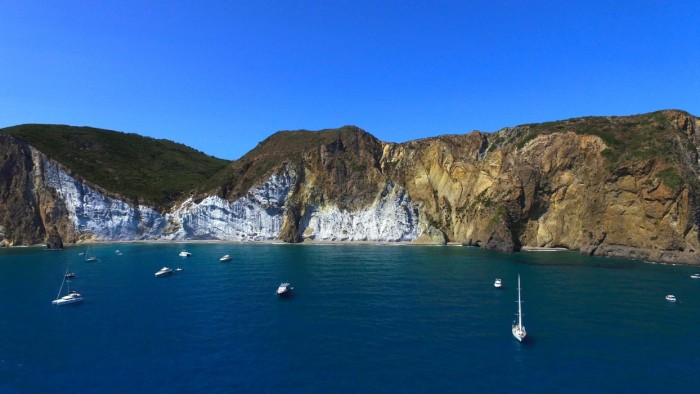
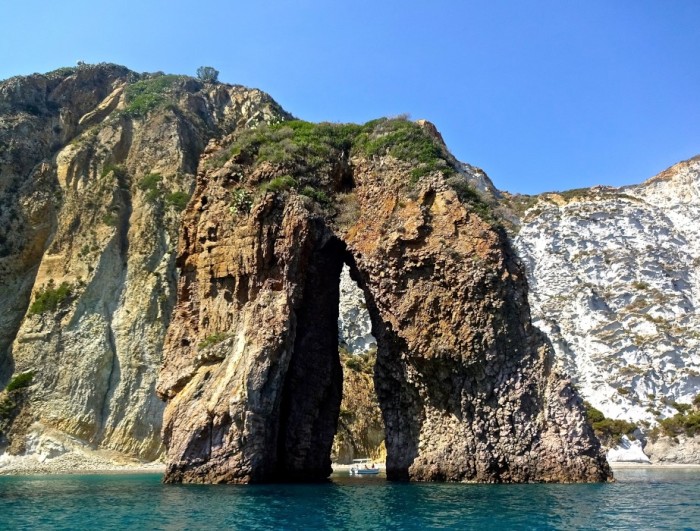
Our brilliant strategy of coping with meteorological challenges in Ponza worked well. With an east wind, we moved Berkeley East to Chiaia di Luna, the gorgeous beach on the island’s west side where a hotel on the cliff played classic music as the sun set into the water.


If things got dicey from the west, north or south, we parked BE near Porto, under the famous bleeding heart.


The weather was good but for a few passing storms. One evening we were setting the table for dinner when one of us said, “It looks like rain.” “There’s none in the forecast” was the reply. “I see lightening,” was the response. “But it’s not at all close,” was the retort. “It’s raining.” “Just a few drops.” As we were grabbing dishes sliding off the table due to the fact that Berkeley East was heeling with the 40-knot gusts, and a deluge of water pounded the deck, the tension was cut when one of us asked, “Shall I plate?”

After the first week, the Italians went back to work and the atmosphere calmed considerably. We slid into a routine between time on land, and time on the water. The woman at the market stopped asking for a pin with our credit card. The server at our favorite restaurant always had our seaside table ready. The fishermen smiled when we squeezed our dinghy into the corner just outside the “Riservato” sign on the wall.
We did a little boat work, waxing and polishing until Berkeley East’s topside was shining bright.
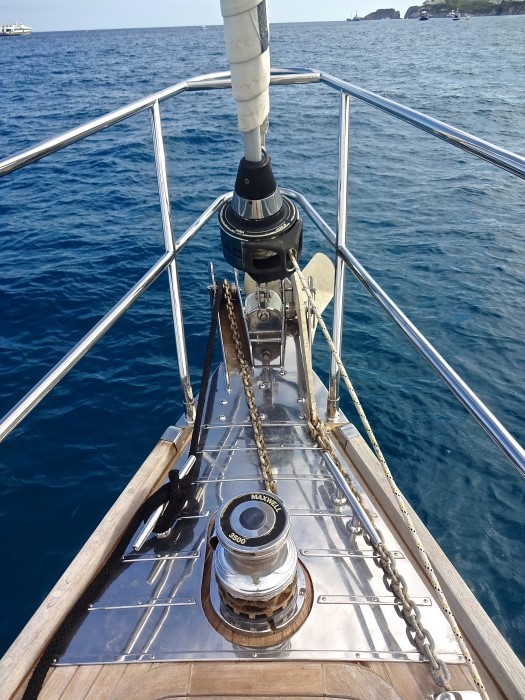
We got out for some day sailing, launching the spinnaker for the first time in a very long while. The light-wind sail is huge, about 2,000 square feet, weighs about 50 pounds and is stowed deep in BE’s sail locker, so it takes planning and effort to launch the monster. And the wind speed and direction must be precise to keep the sail full. Day sailing off Ponza, we were able to pick the right time, the right direction and just sail to the wind.

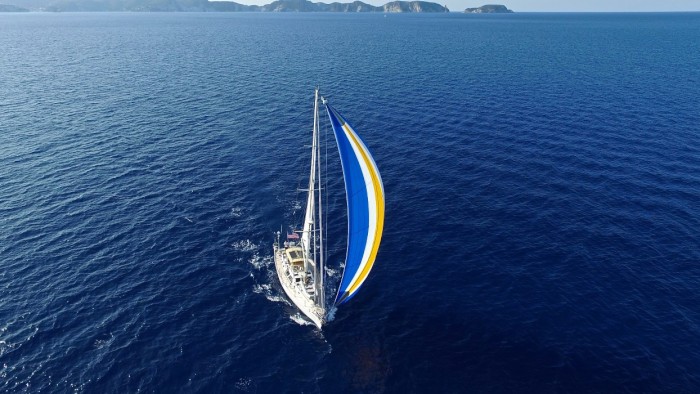
Once we spent the better part of a day watching the recovery of a 130-foot motor yacht that ran up on the rocks, 50 feet from shore. It was amazing to observe the process. The anchors and chains were dropped to remove weight from the bow and fenders were floated marking their location. Divers stuffed pillows in what must have been a hole in the hull and pumps were brought onboard to manage the flooding. Tarps were draped to hide the damage and the name of the yacht. It was surprising that a small salvage boat was able to pull such a large vessel off at high tide and tow it into the harbor. Fortunately, the boat didn’t sink and no one was hurt, but the captain’s career certainly took a beating.
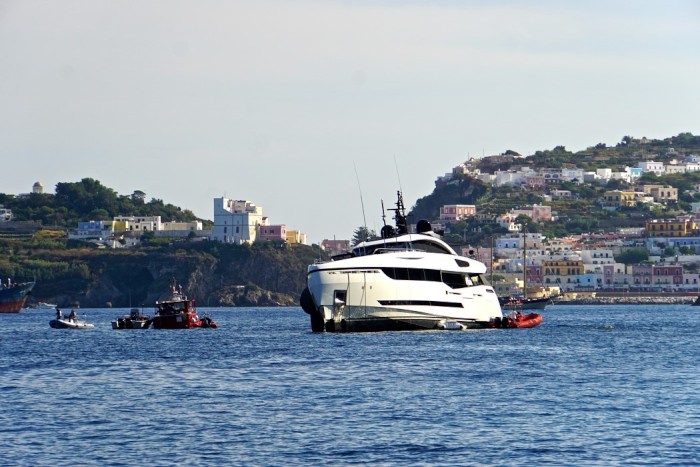
The days passed quickly. September is truly our favorite month to cruise in the Med. There are fewer boats, fewer tourists, cooler temperatures. But the timing of the Mediterranean cruising season often conflicts with special events and occasions back home; while we are on BE making new memories, we miss a lot of memorable moments with the people in our landlubber life. So we were happy to be going back a bit early to attend a good friend’s wedding. We would stay out on the water, in Ponza, as long as possible, soaking up the end of summer.

After 18 days, we said goodbye to Ponza and made the 30-mile crossing to Gaeta. Anchored off the town on our last night out, watching our last sunset of the season, we were contemplating the week ahead, and reminiscing about the past months. We recalled meeting a couple in April who were new to cruising. They had a plan to go from Italy, through Croatia and Greece to Turkey, then all the way back and north to England, in one summer. They had a list of countries that they wanted to say they’ve been to, even if it was only a drive-by. Coming off nearly three weeks at one small Italian island, the thought of such an ambitious schedule was horrifying to us. We used to be in a hurry as well, often being the first of our cruising group to leave the winter nest. But after more than a decade of traveling on Berkeley East, we have learned that it doesn’t matter how far we go, or how fast we get there. What matters most to us is savoring, and appreciating, every experience; the good, the bad, and the ugly.